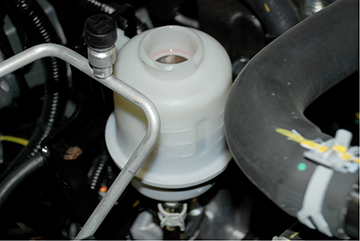TITAN/TITAN XD POWER STEERING FLUID LEVEL CHECK, FILL, AND AIR BLEED PROCEDURE
When should you refill and bleed the power steering hydraulic system?
You should always check for proper fill level and bleed the power steering system whenever you replace or repair a system component.
You should also perform this procedure if your customer has:
- Experienced excessive pump noise (clicking or buzzing)
- Air bubbles in the reservoir tank, or
- Described a notchy steering condition
Any of these concerns could be symptomatic of air in the power steering system or an incorrect fluid level.

Why this is important
Filling the power steering reservoir on most Nissan and Infiniti vehicles is a routine procedure. However, the TITAN/TITAN XD power steering fill procedure is very different. If the procedure is not followed properly, the pump may be damaged or air could get into the system.
Several items you may not think about when filling a power steering reservoir, but that are very important to this procedure, are:
- The fluid temperature must be between 0° - 30°C (32° - 86°F) (you’ll need a thermometer).
- The engine must be OFF to check the fluid level, but ON when instructed.
- Turn the front wheels fully left until the steering wheel hits the steering stop before filling the reservoir.
- You will need an assistant.
- You will need to fill the tank 4 to 6 times.
- If the fluid foams too much, you will need to take a break in the procedure to let the fluid rest.
![]()
- DO NOT start the engine until instructed in this procedure or pump damage may occur.
- Only run the engine as long as instructed or new air may be drawn into the power steering system and pump damage may occur.
- Check and adjust the fluid level with the engine OFF and the power steering fluid temperature between; 0° - 30°C (32° - 86°F).
- Checking and adjusting the fluid level at temperatures not in the range specified could result in too much or too little fluid and possible pump damage.
- Always perform a leak inspection after the refilling and air bleeding procedure is complete.
Fluid Level Check
Whenever possible, check the fluid level when the:
- Fluid is cold
- Engine is stopped
Fluid Level
When the power steering fluid temperature is between 0° - 30°C (32° - 86°F):
- The level should be between the COLD MIN and the COLD MAX lines.
- If the fluid is at or below the COLD MIN line, add fluid to the COLD MAX line.
When the power steering fluid temperature is between 50° - 80°C (122° - 176°F):
- The level should be at the HOT MAX line.
- the level is below the HOT MAX line, add fluid to the HOT MAX line.
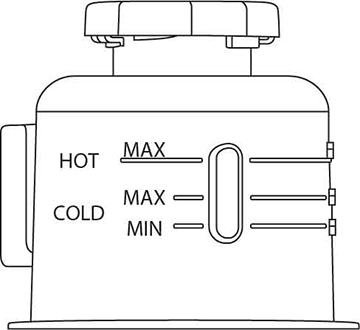
![]()
- DO NOT overfill.
- DO NOT reuse power steering fluid.
- Recommended power steering fluid is NISSAN Power Steering Fluid or equivalent.
Refilling and air bleeding the power steering hydraulic system
NOTE:
The following procedure will require an assistant when performing steps 10 through 13.
1. The power steering components and fluid should be at room temperature before starting this procedure.
2. Verify that all of the power steering hydraulic connections are made and tightened to specifications.
3. Turn the front wheels fully left, lightly touching the wheel stop.
4. Fill the power steering fluid reservoir to the top just below the neck and install the power steering fluid reservoir cap.
5. Start the engine. After 2 seconds, stop the engine.

![]()
- DO NOT run the engine for more than 2 seconds or new air may be drawn into the power steering system and pump damage may occur
- DO NOT turn the steering wheel at this time or new air may be drawn into the power steering system and pump damage may occur.
6. Remove the power steering fluid reservoir cap and fill the power steering fluid reservoir to just below the neck at the top. Reinstall the power steering fluid reservoir cap.
7. Repeat steps 5 and 6 until the power steering fluid level stabilizes just below the neck.
NOTE:
- The reservoir will need to be filled approximately 4 to 6 times.
- If the power steering fluid is extremely foamy, allow the vehicle to stand for a few minutes, and then repeat steps 4, 5 and 6.
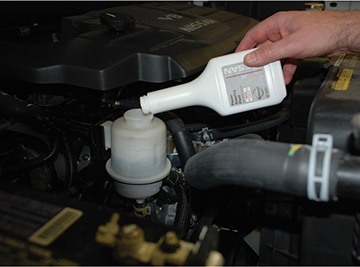
8. Remove the power steering reservoir cap.
9. Verify that the power steering fluid has stabilized at the top of the reservoir just below the neck. Add more power steering fluid if necessary.
NOTE:
Complete steps 10 through 13 without stopping between steps.
10. Have an assistant start the engine. The power steering fluid reservoir level will immediately begin to drop.
11. Quickly add power steering fluid as needed to keep the fluid level at the COLD MAX line until the fluid level has stabilized.
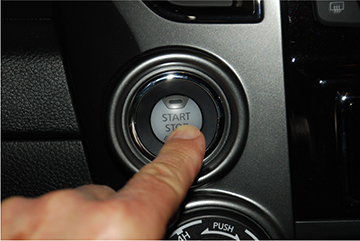
12. Keep the engine running and have your assistant slowly turn the steering wheel completely from the left to the right, and then back to the left, lightly contacting the steering stops at the end of each turn, while you add power steering fluid to keep the fluid level at the COLD MAX line.
NOTE:
"Slowly" in this instance means approximately 1/4 turn per second of the steering wheel.

Have an assistant slowly turn the steering wheel completely from the left to the right.
13. Reinstall the power steering reservoir cap and then have your assistant stop the engine.
14. Check the power steering reservoir fluid level with the engine stopped.
15. Remove the power steering reservoir cap and adjust the fluid level to the COLD MAX line. Reinstall the power steering reservoir cap.
16. Start the engine and moderately turn the steering wheel from the left to the right, and then back to the left, lightly contacting the steering stops at the end of each turn. Stop the engine.
NOTE:
"Moderately" in this instance means approximately 1/2 turn per second.
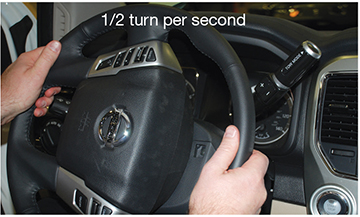
17. With the engine stopped, check the power steering reservoir fluid level.
18. Remove the power steering reservoir cap and adjust the fluid so that the level is at the COLD MAX line. Check the power steering fluid for air bubbles or foam.
19. Repeat steps 16, 17 and 18 until the power steering reservoir fluid level has stabilized at the COLD MAX line and air bubbles or foam are no longer present in the fluid.
20. Adjust the final fluid level to the COLD MAX line at a fluid temperature of 0° - 30°C (32° - 86°F).
21. Reinstall the power steering reservoir cap.
22. Inspect for power steering fluid leaks.
NOTE:
If the power steering fluid is extremely foamy, allow the vehicle to stand for a few minutes, and then repeat steps 9 through 19 until the air bubbles or cloudiness are no longer present.
